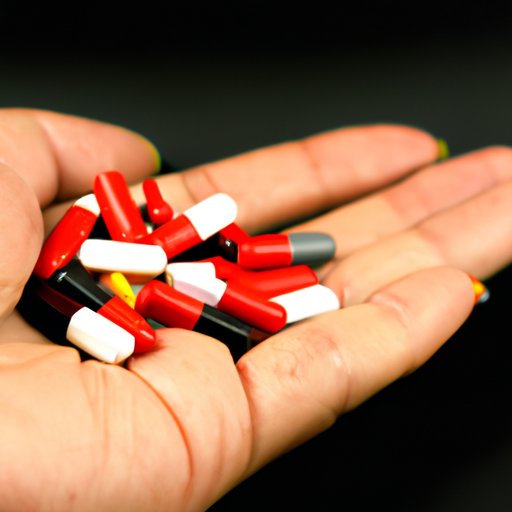
I. Introduction
Acquired Immune Deficiency Syndrome, commonly known as AIDS, is a disease that affects millions of people worldwide. It is caused by the Human Immunodeficiency Virus (HIV), which attacks the immune system, leaving the body vulnerable to diseases and infections. A diagnosis of AIDS does not necessarily mean death, but it requires lifelong management and treatment. In this article, we will explore the basics of AIDS, including how it progresses, symptoms, and global prevalence. We’ll also take a closer look at different aspects of AIDS, including the evolution of treatments, debunking myths, personal stories, stigma, global impact, and future prevention and treatment options.
II. Understanding the basics: How does HIV lead to AIDS and what are the symptoms?
HIV progresses into AIDS when the virus has damaged the immune system so much that the person develops one or more opportunistic infections. These infections can be life-threatening and include pneumonia, Kaposi’s sarcoma, and tuberculosis. Symptoms of AIDS can include prolonged fever, weight loss, night sweats, and swollen glands. According to the World Health Organization (WHO), 38 million people worldwide were living with HIV/AIDS at the end of 2019. Sub-Saharan Africa has the highest prevalence of HIV/AIDS, but the disease affects people in all regions of the world.
III. The evolution of AIDS treatments: From AZT to modern antiretroviral therapy (ART)
AZT was the first FDA-approved drug for the treatment of AIDS in 1987. Since then, AIDS treatment has come a long way. Today, antiretroviral therapy (ART) is the standard treatment for HIV/AIDS. ART involves taking a combination of drugs that target different stages of the virus’s life cycle. While ART has improved the quality of life for people living with AIDS, it does have some drawbacks, including side effects, the need for lifelong adherence, and cost. However, advancements in AIDS treatment research are making great strides in finding new medication and approaches.
IV. Debunking myths about HIV and AIDS: Separating fact from fiction
Misconceptions about HIV, like many other sensitive topics, are rife. It is not true that only gay or bisexual men and people who inject drugs can contract the disease. HIV can affect anyone, regardless of their race, gender, or sexual orientation. HIV is not transmitted through activities like hugging, kissing, and sharing toilets. The virus is primarily spread through unprotected sexual intercourse, sharing needles or equipment with someone who has HIV in them, or through mother-to-child transmission during pregnancy, childbirth, or breastfeeding. By educating the public about how the disease is spread, we can reduce the stigma and increase awareness about how to prevent the spread of the infection.
V. Living with AIDS: Personal stories of those who have been diagnosed with the condition
The impact of AIDS on people’s lives goes beyond medical treatment and can affect their emotional and mental wellbeing. Sharing stories from people who have been diagnosed with AIDS can provide insights about their experiences. These stories will highlight challenges lived and the successes that come with a diagnosis of AIDS. Support, resources, and access to treatment are vital elements of improving the quality of life for people living with AIDS, reducing the stigma affecting them, and combating misinformation.
VI. Addressing the stigma surrounding AIDS: How discrimination can exacerbate the disease
Stigma and discrimination are among the significant challenges people living with AIDS face. People with AIDS can be discriminated against in education, employment, healthcare, and other areas of their lives. Such attitudes can lead to social marginalization, sexual rejection, physical violence, and barriers in accessing care services, leading to poor health outcomes and long-term economic impacts. Creating a supportive and respectful environment is critical to ensure that people living with AIDS can access the resources and support they need to manage their condition successfully.
VII. The global impact of AIDS: Examining the epidemic in different parts of the world
AIDS has a significant global impact, with multiple countries having high prevalence rates. The disease has a disproportionate impact on disadvantaged populations, including those living in poverty and sexual and gender minorities. These groups face stigma, violence, poverty, and discrimination, making it difficult for them to access essential health and social services. In countries where AIDS is common, efforts have been made to improve care services and create behavior change to prevent the spread of the disease. In lower income and resource-limited countries, access to medication and other essentials continue to be a severe challenge.
VIII. The future of AIDS prevention and treatment: Progress being made towards a cure and new preventative measures
Despite the progress made in treating AIDS, there is still no cure. However, current research shows tremendous promise and avenues to explore. The goal is to find a cure that will eliminate the virus from people’s bodies, currently, there is no reliable cure that exists, but there are antiretroviral medications and therapy that can prevent people from contracting AIDS. Promising developments are being made in the field of vaccines, behavioral interventions, pre-exposure prophylaxes (PrEP), and other treatment options that can help prevent or reduce the disease’s spread.
IX. Conclusion
AIDS is a complex disease that affects millions of people worldwide. As we’ve seen, understanding its basics, the evolution of treatments, debunking myths, personal stories, the global impact of AIDS, addressing stigma, and the future of prevention and treatment is crucial. It is imperative to combat stigma and discrimination and create a supportive environment for people living with AIDS.
Bottom line: Despite some progress made since the early days of AIDS, there is still significant work to be done towards combatting the disease. By raising awareness, eradicating stigma, increasing access to treatment, doing more research into prevention and treatment options, and pushing for change on a global scale, we can get one step closer to winning the war against AIDS.




